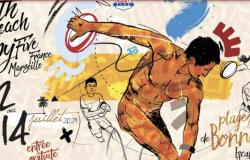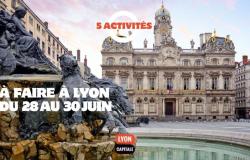
the essential
The CAP ortho-prosthetist students from the Anne Veaute high school in Castres unveiled a unique project to their patient on Wednesday, a personalized prosthesis covering. Their objective: to draw attention to art instead of disability.
“It’s extraordinary,” expresses with emotion Julien Butraud, a 40-year-old amputee banker who came from Toulouse to collect the masterpiece. Under the moved eyes of Anne Veaute’s CAP ortho-prosthetist students, he tries on dressing in the colors of the cartoon that marked his life: Dragon Ball. A round of applause then rings out, the students have succeeded in their challenge. “It really allows us to change our vision of disability,” says Julien.
The students are part of the new CAP module, an artistic module intended to dress prostheses to make them real works of art more than simple medical objects. They worked all school year on this project, discussing regularly with Julien to be sure to deliver a model in his image.
The trans-tibial prosthesis he wears, printed in 3D, was hand-painted by the students. The project was carried out in partnership with the company Apparlage Sud Prosthesis – Toulouse.
They ended up winning the regional Industry prize in Sorèze thanks to their achievement. Pauline Richer, who submitted the application for the project, feels relieved: “it took us a lot of time,” she says. “One-off orders like that don’t happen too often,” she adds. Prosthesis coverings are expensive. They are not reimbursed by social security, unlike the prostheses themselves.
Artistic process
“When you are an amputee, you want to hide it,” explains Julien. “The project breaks this idea, we are attracted by the pure graphic and artistic side,” he says. The aesthetics provided by the prostheses aim to make people more accepting of their disability.
“They show it, it becomes like an accessory, a jewel,” explains one of the two teachers of the training, Paul Pereira. “Usually, we try to hide the disability with flesh-colored prostheses,” says Laure Froquiere, also a teacher at CAP.
The covering was made of plastic. The decorating patterns were painted with acrylic and covered with a special varnish to ensure durability and resist water. The objective is to be able to repeat the experiment next year, this time on the prosthesis of one of the students in the CAP class. Mathéo would like an NBA-themed design, with his favorite team: the Chicago Bulls.
Expanding sector
In addition to the CAP flagship project, the Anne Veaute high school encourages other initiatives from the orthoprosthesis center. BTS students went to Morocco, to Casablanca, for two weeks to make around twenty prostheses for veterans. The vocational baccalaureate students created a comic strip to raise awareness among children about disabilities. It consists of two stories, each featuring futuristic prostheses.
CAP students also seek to change the generally received image of their sector. “The tendency is still to believe that manual learning is not rewarding,” laments Julien. However, the students are in the running for the Colbert Foundation’s national masterpiece competition, in the Industry category. The results will be announced in early July.





